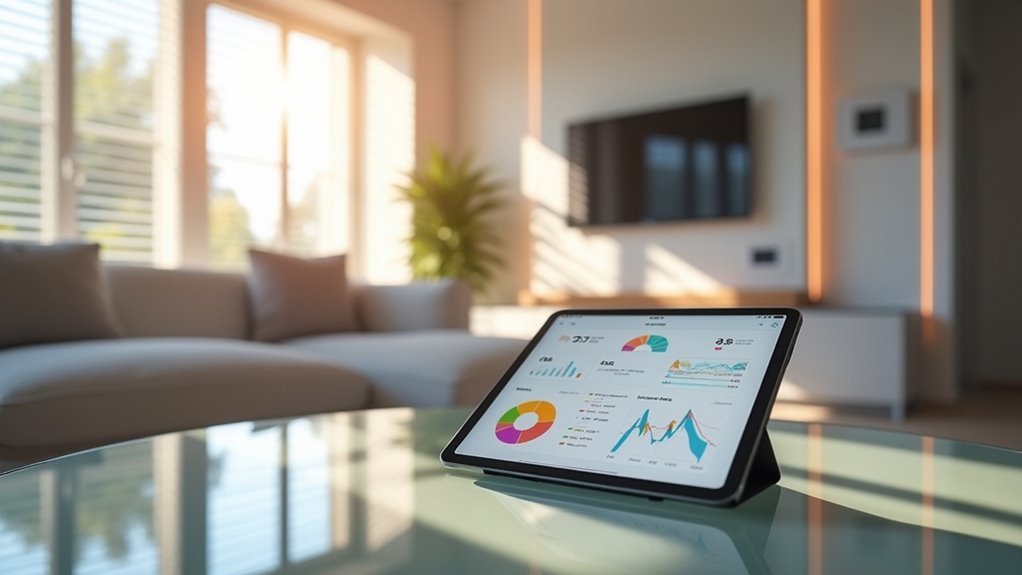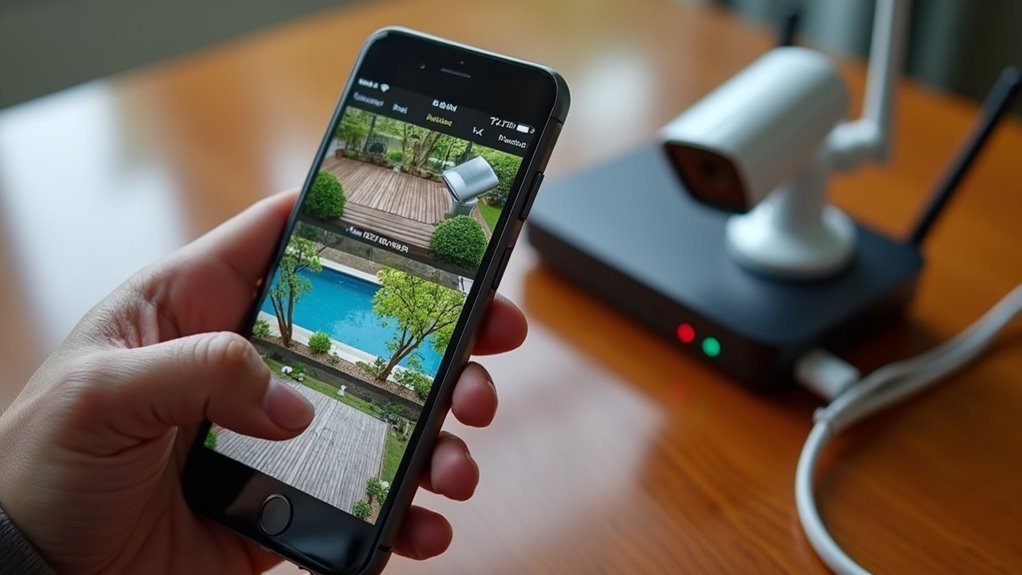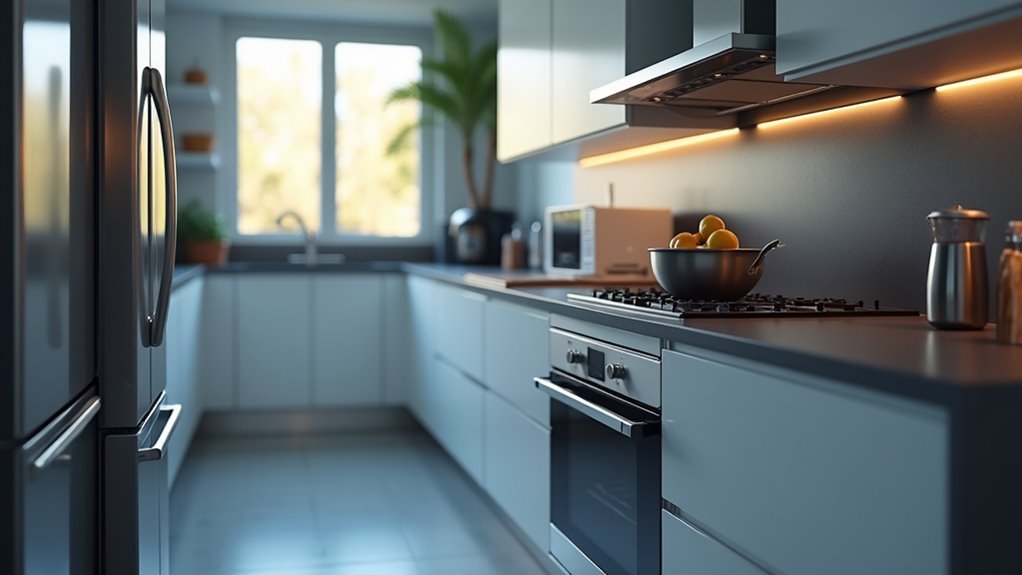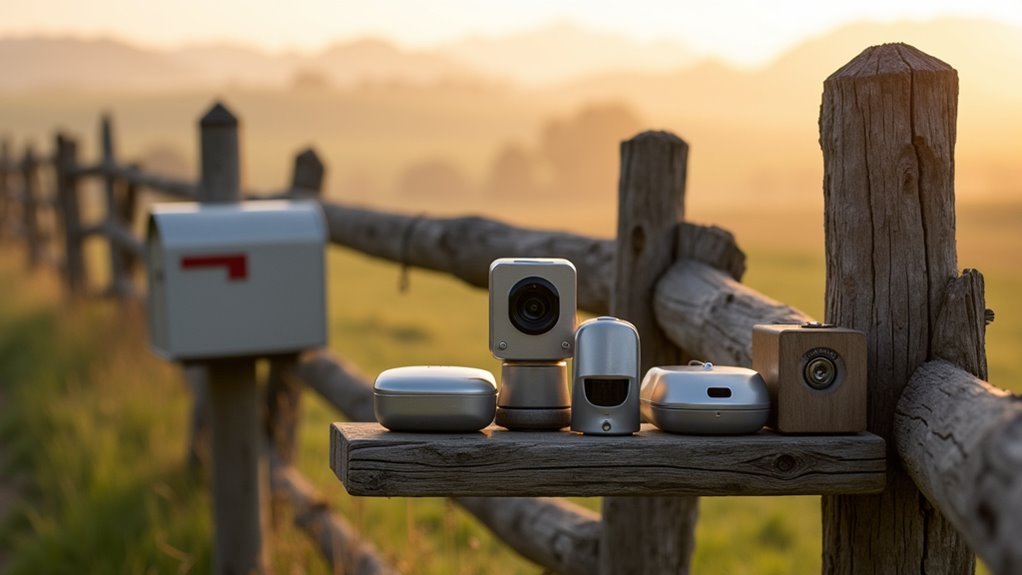You’ll discover that managing dozens of smart devices through separate apps becomes overwhelming fast. Creating a unified web-based dashboard transforms chaos into control, letting you monitor everything from lighting to security cameras in one sleek interface. While the concept sounds straightforward, you’re about to encounter decisions that’ll determine whether your dashboard becomes an elegant command center or a frustrating digital mess that nobody wants to use.
Understanding Web-Based Dashboard Platforms

While traditional smart home apps tie you to specific mobile devices, web-based dashboard platforms break these limitations by running directly in your browser. You can access your smart home controls from any device with internet connectivity, whether you’re using Android, iOS, Windows, or Mac.
These platforms integrate seamlessly with popular hubs like Home Assistant and SmartThings, creating unified home automation experiences. You’ll monitor device status in real-time while controlling lights, sensors, and thermostats from customizable interfaces.
The drag-and-drop functionality lets you arrange tiles according to your preferences, putting frequently used controls within easy reach. Remote access capabilities mean you’re never disconnected from your smart home.
Security features like PIN protection and guest sharing guarantee your system remains secure while providing necessary access to family members.
Essential Features for Smart Home Control Interfaces
When you’re building or choosing a smart home dashboard, you’ll need features that let you monitor your devices in real-time and customize the interface to match your preferences.
Real-time monitoring gives you instant updates on device statuses, so you can see at a glance whether your lights are on, doors are locked, or sensors have detected activity.
A customizable interface guarantees you can arrange tiles, choose colors and icons, and organize your dashboard exactly how you want it for maximum usability.
Real-Time Device Monitoring
As smart home ecosystems expand, you’ll find that real-time monitoring becomes the cornerstone of effective home automation control.
Your unified interface displays instant status updates for all devices at home, showing locked doors, active lights, and running appliances in one extensive view. You can quickly identify which systems are operational through customized tiles featuring distinct icons, labels, and colors that highlight critical alerts.
Smart home dashboards streamline your daily routines with quick tap controls for common actions like thermostat adjustments or door locking.
You’ll appreciate the integrated live feeds displaying camera footage, weather forecasts, and news updates alongside device statuses.
Remote access capabilities guarantee you maintain complete control over your smart home environment from anywhere, providing peace of mind whether you’re at work or traveling.
Customizable Interface Design
Since every household operates differently, your smart home dashboard should reflect your unique lifestyle through fully customizable interface design.
You can create personalized dashboards using intuitive drag-and-drop functionality to arrange smart home controls exactly where you need them.
Your customization options include:
- Drag-and-drop tiles for effortless organization of device controls
- Orientation adjustment for seamless landscape and portrait viewing experiences
- Visual customization with unique icons, labels, colors, and personalized styling options
- Live feed integration for weather forecasts and news updates alongside device management
- PIN protection for critical controls ensuring enhanced security of sensitive features
You’ll enjoy complete flexibility in organizing controls according to your daily routines while maintaining ideal functionality across all your devices and screen sizes.
Choosing the Right Dashboard Creation Tool

When you’re selecting a dashboard creation tool, you’ll need to evaluate three critical factors that determine whether the solution will work effectively in your smart home environment.
First, assess platform compatibility to guarantee the tool integrates seamlessly with your existing hub, whether that’s SmartThings, Hubitat, or Home Assistant.
You’ll also want to examine the customization options and integration capabilities to confirm the tool can adapt to your specific automation needs and visual preferences.
Platform Compatibility Considerations
Before you plunge into creating your smart home dashboard, you’ll need to choose a platform that plays well with your existing ecosystem. Compatibility determines whether your dashboard will seamlessly integrate with your current setup or become a frustrating bottleneck.
Here are essential compatibility factors to evaluate:
- Hub Integration – Verify support for SmartThings, Hubitat, Home Assistant, and Homey
- Device Coverage – Confirm compatibility with lights, plugs, sensors, thermostats, and locks
- Cross-Platform Access – Validate responsive web interfaces work across Android, iOS, Windows, Mac, and Fire Tablets
- Security Features – Look for guest sharing and PIN protection options
- Privacy Policy – Review data handling practices for your Home’s sensitive information
The right platform accommodates your wide range of devices while maintaining robust security standards for peak smart home control.
Customization Features Available
After selecting a compatible platform, you’ll discover that modern dashboard creation tools offer extensive customization features that transform basic device controls into personalized command centers.
You can drag and drop elements to create layouts that perfectly suit your needs, whether monitoring doors and windows or controlling lighting systems. Customize tiles with unique icons, labels, colors, and styles that match your aesthetic preferences.
Your dashboard automatically optimizes for both landscape and portrait orientations, ensuring seamless functionality whether you’re using a tablet with a charging cable or running Fully Kiosk Browser on a wall-mounted display.
Implement PIN protection for sensitive controls or enable view-only modes for enhanced security across your smart home ecosystem.
Integration Capabilities Assessment
While customization features enhance your dashboard’s appearance and usability, the tool’s integration capabilities determine whether it’ll actually work with your smart home setup.
Your dashboard’s effectiveness depends on how well it communicates with your existing devices and platforms. Before committing to any tool, check its compatibility with your current ecosystem.
Essential integration factors include:
- Hub compatibility – Check support for SmartThings, Hubitat, and Home Assistant platforms
- Device variety – Confirm coverage for lights, plugs, sensors, thermostats, and other components
- Cross-platform access – Look for responsive web interfaces working on Android, iOS, Windows, and Fire Tablets
- Advanced functionality – Verify support for automation rules, variables, and logic expressions
- Real-time communication – Confirm instant device status updates and command execution
Choose tools that seamlessly bridge your devices rather than creating integration headaches.
Setting Up Your First Custom Dashboard

How do you transform your smart home from a collection of individual devices into a unified control center? Start by accessing the web-based interface and using the intuitive drag-and-drop layout to position your customizable tiles. These tiles represent your devices, modes, and routines for quick monitoring and control.
| Dashboard Element | Function | Best Practice |
|---|---|---|
| Device Tiles | Control individual devices | Group by room or function |
| Mode Tiles | Switch home states | Place prominently for quick access |
| Routine Tiles | Execute automated sequences | Use descriptive labels |
| Security Controls | Manage sensitive functions | Enable PIN protection |
| Layout Grid | Organize tile placement | Optimize for landscape/portrait views |
Integrate with SmartThings or Home Assistant for seamless connectivity. Arrange your dashboard to work perfectly on tablets and smartphones while implementing PIN protection for sensitive controls.
Integrating Multiple Smart Home Devices and Protocols
You’ll need to connect devices using different communication protocols like Z-Wave and ZigBee to build an extensive smart home network.
Your dashboard can integrate seamlessly with popular hubs such as SmartThings, Hubitat, Home Assistant, and Homey to manage various product lines from one interface.
This multi-protocol approach reduces Wi-Fi congestion while ensuring all your lights, sensors, thermostats, and locks work together efficiently.
Multi-Protocol Device Compatibility
As smart home ecosystems expand, managing devices that speak different communication languages becomes a critical challenge for homeowners seeking unified control.
Multi-protocol compatibility solves this by enabling seamless integration across popular communication standards like Z-Wave and ZigBee, creating a cohesive smart home experience.
Your multi-protocol setup supports diverse device categories:
- Lighting systems – Smart bulbs, switches, and dimmers
- Climate control – Thermostats and temperature sensors
- Security devices – Smart locks and motion detectors
- Power management – Smart plugs and outlet controls
- Environmental monitoring – Humidity, light, and air quality sensors
You’ll reduce Wi-Fi network congestion while improving system reliability.
Hubs like SmartThings, Hubitat, and Home Assistant facilitate these connections, while web-based interfaces let you monitor everything from any modern browser.
Hub Integration Strategies
Successfully connecting multiple protocols requires strategic hub selection and thoughtful implementation planning. You’ll want to choose hubs that support Z-Wave, ZigBee, and Wi-Fi protocols to maximize device compatibility across manufacturers.
| Platform | Protocol Support | Best For |
|---|---|---|
| SmartThings | Z-Wave, ZigBee, Wi-Fi | Beginners seeking simplicity |
| Hubitat | Z-Wave, ZigBee, LAN | Advanced users wanting local control |
| Home Assistant | Universal compatibility | Tech enthusiasts requiring customization |
Focus on creating a unified interface that provides real-time monitoring and control capabilities. You can customize your dashboard using drag-and-drop features to arrange devices according to your preferences. Set up automation rules and triggers based on device status or scheduling to coordinate actions across different platforms, ensuring your smart home ecosystem works harmoniously together.
Designing Intuitive Tile Layouts and Navigation
When designing your smart home dashboard, the tile layout becomes the foundation that determines how efficiently you’ll interact with your connected devices daily.
You’ll want to leverage drag-and-drop functionality to arrange tiles logically, grouping related devices and automations for intuitive access.
Smart layout strategies include:
- Color-coded tiles – Use red indicators for alerts and status-specific colors for instant visual recognition
- Sub-dashboards – Create dedicated screens for lighting, security, and climate control functions
- Responsive design – Optimize layouts for different screen sizes and orientations
- Navigation placement – Position infrequent commands on the bottom row to maintain clean interfaces
- Device grouping – Cluster similar functions together for streamlined workflow
This approach guarantees you’ll navigate your smart home effortlessly while maintaining clear visual hierarchy.
Creating Responsive Dashboards for Different Screen Sizes
Once you’ve established an effective tile arrangement, your dashboard must adapt seamlessly across the various devices you’ll use to control your smart home. CSS scaling factors become your primary tool for maintaining consistent user experiences across different screen sizes.
Implement media breakpoints to define specific scaling rules at various widths, creating smooth shifts between layouts.
Strategic media breakpoints ensure your smart home interface scales flawlessly, delivering consistent control experiences across every device in your ecosystem.
Leverage responsive design principles by adjusting icon and label sizes through CSS transforms, preserving proportionality regardless of screen dimensions. Position dynamic elements accurately by centering icons and labels, using transform-origin and translate adjustments for precise alignment.
For tablet-specific dashboards, display relevant floorplans while defining your core element list in a single location. This approach eliminates redundancy across different screens and streamlines your maintenance workflow.
Building Custom Automation Rules and Logic
Beyond creating visually appealing interfaces, you’ll need to establish the intelligent automation logic that transforms your dashboard from a simple control panel into a truly smart home system.
The Rule Engine’s drag-and-drop editor makes building complex automation rules straightforward, eliminating the need for technical coding knowledge.
Your automation capabilities include:
- Flexible triggers – Set rules based on device status, time schedules, or environmental sensor readings
- Nested conditions – Create sophisticated logic for specific scenarios with multiple layered requirements
- Advanced variables – Incorporate dynamic expressions that adapt based on real-time context
- Template library – Access pre-built automation setups for quick implementation and inspiration
- Visual customization – Design rules intuitively without writing code
This powerful combination guarantees your smart home responds intelligently to your lifestyle patterns.
Implementing Security Features and Access Controls
While powerful automation rules form the backbone of your smart home’s intelligence, protecting these capabilities from unauthorized access becomes paramount to maintaining both functionality and safety. You’ll want to implement PIN protection for critical controls and establish view-only modes for guests or family members who don’t need full system access.
| Security Feature | Implementation | Benefit |
|---|---|---|
| PIN Protection | Secure sensitive controls | Prevents unauthorized changes |
| User Roles | Assign permission levels | Customized access control |
| Real-time Alerts | Configure breach notifications | Immediate security updates |
| Visual Status Tiles | Display lock/camera states | Quick security verification |
Set up user roles based on individual needs, integrate real-time alerts for security events, and maintain regular software updates to protect against vulnerabilities.
Adding Dynamic Visual Elements and Real-Time Updates
After establishing robust security measures, you can transform your dashboard from a functional control panel into an intuitive visual interface that instantly communicates your home’s status.
Transform your dashboard from a basic control panel into an intuitive visual interface that instantly communicates your home’s status.
Picture Elements cards become your primary tool for overlaying dynamic content onto background images, creating immersive visual representations of your living spaces.
Dynamic visual elements provide immediate feedback through:
- Jinja2 template integration – Update device states automatically with real-time sensor data
- CSS-based responsive design – Guarantee elements scale properly across different screen sizes
- Opacity adjustments – Reflect environmental changes like light levels through visual transparency
- Drag-and-drop customization – Position elements precisely without coding knowledge
- State-based color coding – Instantly identify device status through visual color changes
These features transform static dashboards into living representations of your smart home environment.
Optimizing Performance for Wall-Mounted Tablets
Creating visually stunning dashboards means nothing if your wall-mounted tablets can’t deliver consistent performance throughout the day.
You’ll want to choose energy-efficient models like the Samsung Tab A 8″ or 10″, which feature motion detection to activate displays and minimize power consumption when idle.
Install Fully Kiosk Browser to manage your tablet’s interface, providing seamless dashboard access with remote monitoring capabilities.
Route power supplies through USB cables behind drywall for a clean appearance while maintaining easy maintenance access.
Implement magnetic mounting systems that allow convenient removal without wall damage.
You’ll need to monitor battery status using a dedicated sub-dashboard and replace batteries every 10 days to guarantee peak performance and uninterrupted functionality throughout your smart home system.
Troubleshooting Common Dashboard Configuration Issues
Even with proper hardware setup, you’ll encounter dashboard configuration issues that can disrupt your smart home’s functionality.
These problems typically stem from connectivity, software compatibility, or misconfigured settings that prevent devices from responding properly.
Most dashboard malfunctions result from poor network connections, outdated software versions, or incorrectly programmed device settings that block proper communication.
Here’s how to resolve the most common issues:
- Check network connectivity – Verify Z-Wave and ZigBee devices have strong signal strength, as weak connections cause dashboard failures.
- Run built-in diagnostics – Use your dashboard’s troubleshooting tools to identify device status and configuration errors.
- Update firmware regularly – Keep both dashboard software and connected devices current to prevent compatibility problems.
- Verify automation rules – Review triggers and conditions to confirm they’re properly configured for expected actions.
- Review access permissions – Validate user rights and PIN settings allow proper device control and dashboard access.
Advanced Customization With CSS and Templates
Once your dashboard runs smoothly, you’ll want to push beyond basic functionality and create a truly personalized interface that reflects your unique needs and aesthetic preferences.
CSS scaling factors and media breakpoints guarantee your dashboard remains responsive across all devices. You can implement dynamic opacity control through Jinja2 templates, providing real-time visual feedback based on environmental conditions like lighting or temperature.
The Picture Elements card lets you position images, icons, and labels precisely over backgrounds for enhanced visual appeal.
Use the card-mod integration to apply custom styles that adjust dynamically based on device states. Create efficiency by defining core element lists in centralized locations, eliminating redundancy and streamlining updates across multiple dashboards while maintaining consistent layouts.
Maintaining and Updating Your Smart Home Interface
After you’ve crafted your perfect dashboard interface, maintaining its performance and functionality becomes crucial for long-term success.
Building the perfect dashboard is only the beginning—consistent maintenance ensures your smart home interface delivers peak performance year after year.
Your smart home ecosystem constantly evolves, requiring ongoing attention to keep everything running smoothly.
Here are key maintenance practices to implement:
- Update dashboard software regularly to access latest features, security patches, and device compatibility improvements
- Monitor battery levels through dedicated sub-dashboards that automatically change tile colors when power drops below 30% and 10%
- Review and adjust automations using the Rule Engine to match changing household routines and optimize efficiency
- Verify device compatibility when adding new equipment to guarantee seamless integration with existing Z-Wave or ZigBee protocols
- Customize layouts frequently using drag-and-drop interfaces to adapt tiles and colors as your smart home needs shift
Frequently Asked Questions
How Do I Create a Custom Home Assistant Dashboard?
You’ll model your home in 3D using SketchUp, then use Picture Elements cards to overlay dynamic icons on your base image. Apply CSS scaling and Jinja2 templates for responsive, real-time dashboard updates.
How Do I Make My Home a Smart Home With Google?
You’ll start by getting a Google Assistant-compatible smart speaker or display as your hub. Download the Google Home app, add compatible smart devices, create rooms, set up routines, and control everything remotely.
What Do Smart Homes Use Devices That Are Internet and Dash Enable?
Smart homes use internet-enabled devices like smart lights, thermostats, sensors, locks, and plugs that connect through protocols such as Z-Wave and ZigBee, allowing you to monitor and control everything remotely.
How Do I Get to Home Assistant Dashboard?
You’ll access your Home Assistant dashboard by entering your local IP address into any web browser on your network. If you’ve configured remote access, you can use the configured URL or mobile app from anywhere.





Leave a Reply